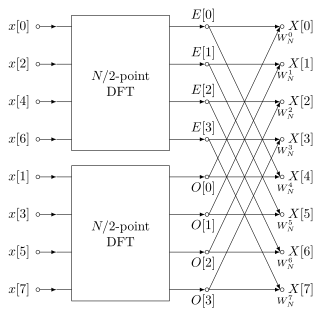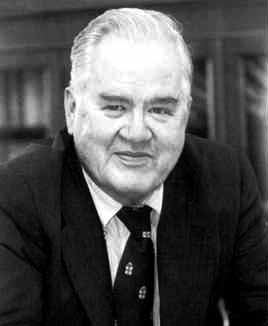Related Research Articles

A fast Fourier transform (FFT) is an algorithm that computes the discrete Fourier transform (DFT) of a sequence, or its inverse (IDFT). Fourier analysis converts a signal from its original domain to a representation in the frequency domain and vice versa. The DFT is obtained by decomposing a sequence of values into components of different frequencies. This operation is useful in many fields, but computing it directly from the definition is often too slow to be practical. An FFT rapidly computes such transformations by factorizing the DFT matrix into a product of sparse factors. As a result, it manages to reduce the complexity of computing the DFT from , which arises if one simply applies the definition of DFT, to , where n is the data size. The difference in speed can be enormous, especially for long data sets where n may be in the thousands or millions. In the presence of round-off error, many FFT algorithms are much more accurate than evaluating the DFT definition directly or indirectly. There are many different FFT algorithms based on a wide range of published theories, from simple complex-number arithmetic to group theory and number theory.

Kevlar (para-aramid) is a strong, heat-resistant synthetic fiber, related to other aramids such as Nomex and Technora. Developed by Stephanie Kwolek at DuPont in 1965, the high-strength material was first used commercially in the early 1970s as a replacement for steel in racing tires. It is typically spun into ropes or fabric sheets that can be used as such, or as an ingredient in composite material components.

Linus Carl Pauling was an American chemist, biochemist, chemical engineer, peace activist, author, and educator. He published more than 1,200 papers and books, of which about 850 dealt with scientific topics. New Scientist called him one of the 20 greatest scientists of all time, and as of 2000, he was rated the 16th most important scientist in history. For his scientific work, Pauling was awarded the Nobel Prize in Chemistry in 1954. For his peace activism, he was awarded the Nobel Peace Prize in 1962. He is one of five people to have won more than one Nobel Prize. Of these, he is the only person to have been awarded two unshared Nobel Prizes, and one of two people to be awarded Nobel Prizes in different fields, the other being Marie Curie.
Georges Charpak was a Polish-born French physicist, who was awarded the Nobel Prize in Physics in 1992.

Leon N. Cooper is an American physicist and Nobel Prize laureate who, with John Bardeen and John Robert Schrieffer, developed the BCS theory of superconductivity. His name is also associated with the Cooper pair and the BCM theory of synaptic plasticity.

John Wilder Tukey was an American mathematician and statistician, best known for the development of the fast Fourier Transform (FFT) algorithm and box plot. The Tukey range test, the Tukey lambda distribution, the Tukey test of additivity, and the Teichmüller–Tukey lemma all bear his name. He is also credited with coining the term 'bit' and the first published use of the word 'software'.
The year 1988 in science and technology involved many significant events, some listed below.
The year 1969 in science and technology involved some significant events, listed below.
The year 1923 in science and technology involved some significant events, listed below.
The year 1954 in science and technology involved some significant events, listed below.
The year 1929 in science and technology involved some significant events, listed below.
The year 1970 in science and technology involved some significant events, listed below.
The year 1968 in science and technology involved some significant events, listed below.
The year 1966 in science and technology involved some significant events, listed below.
The year 1963 in science and technology involved some significant events, listed below.
The year 1962 in science and technology involved some significant events, listed below.
The year 1961 in science and technology involved some significant events, listed below.
The year 1948 in science and technology involved some significant events, listed below.
James William Cooley was an American mathematician. Cooley received a B.A. degree in 1949 from Manhattan College, Bronx, NY, an M.A. degree in 1951 from Columbia University, New York, NY, and a Ph.D. degree in 1961 in applied mathematics from Columbia University. He was a programmer on John von Neumann's computer at the Institute for Advanced Study, Princeton, NJ, from 1953 to 1956, where he notably programmed the Blackman–Tukey transformation.

Angelman syndrome or Angelman's syndrome (AS) is a genetic disorder that mainly affects the nervous system. Symptoms include a small head and a specific facial appearance, severe intellectual disability, developmental disability, limited to no functional speech, balance and movement problems, seizures, and sleep problems. Children usually have a happy personality and have a particular interest in water. The symptoms generally become noticeable by one year of age.
References
- ↑ Cohen, Barry M. (1965). "The descent of Lysenko". The Journal of Heredity. 56 (5): 229–233. doi:10.1093/oxfordjournals.jhered.a107425.
- ↑ Joravsky, David (1970). The Lysenko Affair . Russian Research Center studies, 61. Cambridge, Massachusetts: Harvard University Press. ISBN 0-674-53985-0.
- ↑ Zuckerkandl, E.; Pauling, L. (1965). "Evolutionary Divergence and Convergence in Proteins". In Bryson, B.; Vogel, H. (eds.). Evolving Genes and Proteins. New York: Academic Press. pp. 97–166.
- ↑ Morgan, Gregory J. (1998). "Emile Zuckerkandl, Linus Pauling, and the Molecular Evolutionary Clock, 1959-1965". Journal of the History of Biology. 31 (2): 155–178. doi:10.1023/A:1004394418084. PMID 11620303. S2CID 5660841.
- ↑ Kwolek, Stephanie; Mera, Hiroshi; Takata, Tadahiko (2002). "High-Performance Fibers". Ullmann's Encyclopedia of Industrial Chemistry. Weinheim: Wiley-VCH. doi:10.1002/14356007.a13_001. ISBN 3527306730.
- ↑ "Wholly Aromatic Carbocyclic Polycarbonamide Fiber". 1974-06-25. Archived from the original on 2012-03-08. Retrieved 2012-03-02. US patent #3819587.
- ↑ "Scientists warned the US president about global warming 50 years ago today". The Guardian. 2015-11-05. Retrieved 2015-11-06.
- ↑ "The CDC 6600 arrives at CERN". Timeline – Computing at CERN. Geneva: CERN. 1965-01-14. Retrieved 2019-10-20.
- ↑ Jones, Douglas W. "The Digital Equipment Corporation PDP-8" . Retrieved 2012-05-08.
- ↑ Moore, Gordon E. (19 April 1965). "Cramming more components onto integrated circuits" (PDF). Electronics . 38 (8). Archived from the original (PDF) on 18 February 2008. Retrieved 2012-01-20.
- ↑ "Excerpts from A Conversation with Gordon Moore: Moore's Law" (PDF). Intel. 2005. Archived from the original (PDF) on 2012-10-29. Retrieved 2012-01-20.
- ↑ "1965 – "Moore's Law" Predicts the Future of Integrated Circuits". Computer History Museum. 2007. Retrieved 2012-01-20.
- ↑ "Ever more from Moore". The Economist. 18 April 2015. Retrieved 19 April 2015.
- ↑ Ax, James; Kochen, Simon (1965). "Diophantine problems over local fields, I". American Journal of Mathematics . 87 (3): 605–630. doi:10.2307/2373065. JSTOR 2373065.
- ↑ Cooley, James W.; Tukey, John W. (1965). "An algorithm for the machine calculation of complex Fourier series". Mathematics of Computation . 19 (90): 297–301. doi: 10.1090/S0025-5718-1965-0178586-1 . ISSN 0025-5718 . Retrieved 2017-12-30.
- ↑ Crilly, Tony (2007). 50 Mathematical Ideas You Really Need to Know. London: Quercus. p. 65. ISBN 978-1-84724-008-8.
- ↑ Penrose, Roger (January 1965). "Gravitational Collapse and Space-Time Singularities". Physical Review Letters . 14 (3): 57–59. Bibcode:1965PhRvL..14...57P. doi: 10.1103/PhysRevLett.14.57 .
- ↑ Angelman, Harvey (1965). "'Puppet' Children: A report of three cases". Developmental Medicine & Child Neurology . 7 (6): 681–688. doi:10.1111/j.1469-8749.1965.tb07844.x. S2CID 53730099.
- ↑ "History". Crewe: Whitby Morrison. Retrieved 2012-07-12.
- ↑ Whitby, Stuart; Earnshaw, Alan (1999). Fifty Years of Ice Cream Vehicles, 1949–99. Appleby: Trans-Pennine. ISBN 978-1-903016-08-4.
- ↑ U.S. Patent 3,387,396